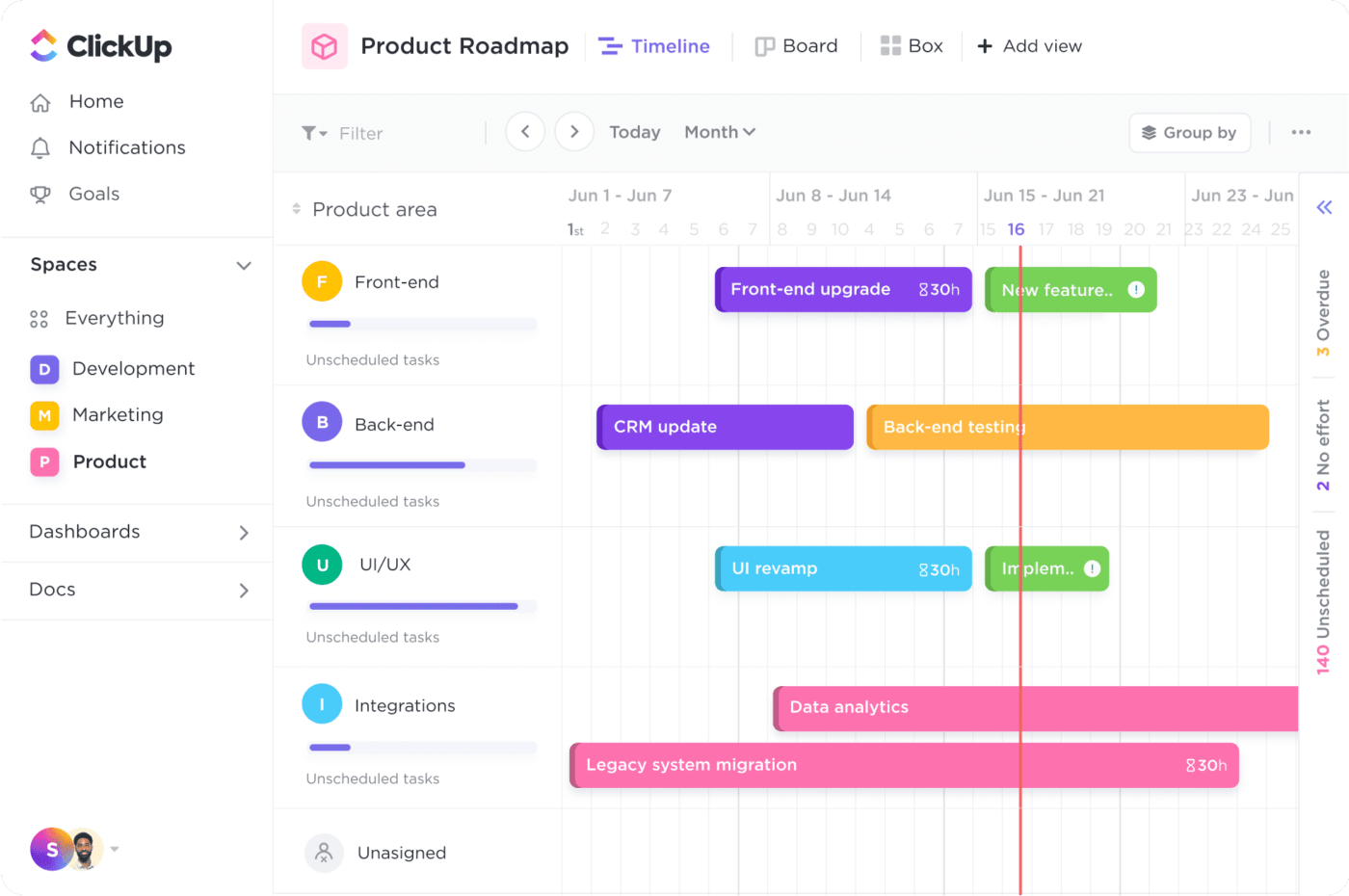تشترك أكبر الشركات اليوم وأكثرها ربحية في شيء واحد: إنها تتمحور حول منتج ما. وسواء أكانت منتجات مادية أو رقمية، استهلاكية أو برمجيات كخدمة (SaaS)، فإن المنتجات هي رافعة النمو في الصناعات اليوم. حتى أن العديد من الشركات اعتمدت على منتجاتها لتحقق لها قوة جذب أولية - وهو ما نسميه الآن "النمو الذي يقوده المنتج"
تعرف المؤسسات ذات التفكير المستقبلي كيفية تسويق منتجاتها وإطلاق العنان لفرص النمو والإيرادات.
ومع ذلك، فإن إظهار مزايا منتجك وقيمته المقترحة هو فن من الفنون. ويتطلب الأمر تخطيطًا وجهدًا واستراتيجية لإيصال منتجك إلى السوق - والحفاظ عليه هناك. استخدم هذا الدليل الشامل لتتعلم كيفية قيادة استراتيجية تسويق منتج ناجحة، حتى لو كنت فريق تسويق منتج واحد.
ما هي استراتيجية تسويق المنتج؟
قبل مناقشة استراتيجية المنتج في التسويق، دعنا نفهم ما يلي إدارة المنتجات .
تركز إدارة المنتج على إدارة دورة حياة المنتج - من التطوير إلى الإطلاق.
استراتيجية تسويق المنتج هي جزء من إدارة المنتج، والتي تدور حول تسويق المنتج وجعله جاهزًا للسوق. تربط هذه الاستراتيجية عملية تطوير المنتج بالوعي بالمنتج في ذهن العميل.
من الناحية المفاهيمية، يستخدم مسوق المنتج استراتيجيات إدارة العلامة التجارية وتكتيكات المبيعات مثل رعاية العملاء المحتملين، والبيع المتبادل، والبيع المتبادل، والبيع الإضافي، وما إلى ذلك، للترويج للمنتجات. بمعنى أن تسويق المنتجات يركز على المبيعات بقدر ما يركز على المنتج.
تسويق المنتجات هو القوة الدافعة لمساعدة الشركات:
- النجاح في وضع نقاط القوة الخاصة بمنتجاتها بنجاح ، وإنشاء رسائل جذابة والترويج لها بشكل استراتيجي
- فهم السوق الذي يعيش فيه المنتج وتفضيلات العميل
- إنشاء استراتيجية طرح المنتج في السوق مع المدخلات التي تم جمعها وبناء استراتيجيات تسويق طويلة الأجل
- بيع المنتج وتشجيع العملاء الحاليين على تكرار الشراء
- زيادة تبني العملاء للمنتج واستخدامه من قبل العملاء
قد تبدو استراتيجية تسويق المنتج مشابهة لاستراتيجيات التسويق التقليدية، ولكن هناك اختلافات دقيقة - فالتسويق التقليدي يروج للشركة أو العلامة التجارية ككل، في حين أن تسويق المنتج أضيق نطاقًا لأنه يركز على المنتج
يركز تسويق المنتج على التسويق للعميل وتسريع الطلب والاعتماد، بينما يركز التسويق التقليدي على اكتساب العملاء وتحويلهم مع ضمان اتساق رسائل العلامة التجارية عبر القنوات.
نظرًا لأن تسويق المنتجات يركز على المنتج، فإنه غالبًا ما يكون جزءًا من وظيفة المنتج داخل الشركة، على عكس بقية وظائف التسويق، التي تتبع رئيس التسويق أو مدير التسويق. مايكل شيبر وهو مدير تسويق المنتجات في جوجل، يشرح ذلك:
_المنتج في هذا المجال يشبه إلى حد كبير مبنى قيد الإنشاء باستمرار. فهو لا يكتمل تمامًا أبدًا؛ فهناك دائمًا تحسينات يمكن إجراؤها، وأعتقد أن هذا ما يميز تسويق المنتج عن أنواع التسويق الأخرى
## التحديات الشائعة في بناء استراتيجية تسويق المنتج
يقع تسويق المنتج عند تقاطع فرق دعم العملاء والمبيعات والمنتج والتسويق.
وفي حين أن هذا يساعد العلامة التجارية على التعامل مع تسويق المنتج بشكل أكثر شمولاً، إلا أنه يعقد العملية. فيما يلي المزالق الشائعة التي يواجهها فريق تسويق المنتج عند إنشاء استراتيجية شاملة:
- المساءلة: هناك نقص في الرؤية حول من يقود استراتيجية إدارة المنتج. فالبعض يعزو هذه المسؤولية إلى فريق التسويق، بينما يعزوها البعض الآخر إلى فريق المنتج أو فريق المبيعات
- التعاون متعدد الوظائف: يجب أن يعمل مسوقو المنتجات مع فرق متعددة، مثل المبيعات والمنتج والعلامة التجارية والدعم وما إلى ذلك، لبناء وتنفيذ استراتيجياتهم. وغالبًا ما يتضمن ذلك إدارة العلاقات مع مختلف أصحاب المصلحة على مستويات مختلفة في المؤسسة، والتأثير دون سلطة، ومحاولة الحصول على تأييد للمبادرات، وكل ذلك يتطلب مهارات متطورة في التعامل مع الأشخاص
- العميل: غالبًا ما تفشل الفرق في فهم احتياجات العملاء الفورية بسبب ضعف الرؤى والأبحاث المتعلقة بالعملاء
- المحاذاة: الافتقار إلى مواءمة القيادة لميزات المنتج والرسائل ومؤشرات الأداء الرئيسية وغيرها
- مؤشرات الأداء الرئيسية: نظرًا للطبيعة التعاونية للدور، يصبح من الصعب قياس تأثير استراتيجيات تسويق المنتجات وتحديده كميًا
- الأولويات: تؤدي الأولويات المتنافسة إلى إضعاف عملية تطوير المنتج وتأخر الإطلاق
كيفية بناء استراتيجية فعالة لتسويق المنتج في 5 خطوات سهلة
استراتيجية فعّالة لتسويق المنتج تضع المنتج بشكل استراتيجي، وتعزز الوعي من خلال العروض الترويجية السياقية وتستفيد من الريادة الفكرية لتعزيز السلطة. ولكن مع وجود فرق المنتج والتسويق والمبيعات وخدمة العملاء التي تعمل بشكل منفصل، يكون هناك انفصال واضح.
في هذا السيناريو، فإن استخدام أداة مثل منصة إدارة المنتجات المتكاملة من ClickUp ستكون خطوة في الاتجاه الصحيح. تتميز ClickUp بوظائفها القابلة للتخصيص بدرجة عالية، فهي تحرر فرق العمل من عدم الكفاءة والوقت الضائع.

العمل معًا، من الفكرة إلى الإطلاق، مع برنامج ClickUp لإدارة المنتجات
تحل هذه الأداة المركزية محل جميع برامج الإنتاجية والاتصالات وإدارة المهام في جميع الأقسام، وتتيح التعاون مع تطبيق واحد للمهام والمستندات والدردشة والأهداف وإدارة الفريق.
يبقى السؤال الحقيقي كيف يمكنك إنشاء استراتيجية تسويق للمنتج لجلب منتجك إلى العميل الذي يضرب به المثل؟ إليك قائمة مرجعية خطوة بخطوة:
الخطوة 1: تعرّف على العملاء المثاليين لمنتجك وأنشئ شخصية
ابدأ باكتساب معرفة عميقة بعملائك المستهدفين لإنشاء شخصية مشترٍ مدروسة جيدًا
- افهم نقاط ضعفهم واهتماماتهم وتوقعاتهم ودوافعهم
- تعرف على القنوات التي يتردد عليها عملاؤك للوصول إلى منتجك
- البحث عن العملاء الحاليين للحصول على رؤى حول المشاكل التي يواجهونها
- إجراء أبحاث السوق باستخدامبرنامج تحليلات التسويق ومقارنة المنتجات المماثلة لتحديد نقاط قوة منتجك ونقاط ضعفه
- تحليل التركيبة السكانية والمجموعات حسب السمات المشتركة مثل التعليم ومستويات الدخل والمسار الوظيفي وما إلى ذلك، والخصائص الفريدة مثل الاهتمامات والسلوكيات وما إلى ذلك
- إذا كان المنتج عبارة عن حل B2B، أضف طبقة من البيانات الديموغرافية للشركة مثل نوع الصناعة وحجم الشركة وما إلى ذلك.
- استخدم البيانات لإنشاء 2-3 شخصيات مشترية تمثل قاعدة عملائك المثالية على أفضل وجه
تصبح البيانات التي تجمعها عند إنشاء شخصية المشتري أساس متطلبات منتجك لدورة التطوير التالية. ولضمان جمع البيانات وتخزينها ومشاركتها بشكل مناسب، استفد من ClickUp Brain -أداة مدعومة بالذكاء الاصطناعي تعمل على تبسيط إدارة المنتجات.

إنشاء مستند متطلبات المنتج باستخدام ClickUp Brain
استخدم مطالبات الذكاء الاصطناعي الصحيحة لتطوير مستند شامل لمتطلبات المنتج ، وقم بتعيينه وفقاً لاحتياجات عميلك، وشاركه مع الفريق بنقرة واحدة. سواء كنت ترغب في تتبع خطط منتجك ووثائقه بسرعة أو تبسيط ملاحظات العملاء، يمنحك ClickUp Brain الأدوات التي تحتاجها في مكان واحد.
الخطوة 2: العصف الذهني لوضع المنتج والرسائل
يتمحور تحديد موقع المنتج والرسائل حول توضيح كيف يمكن لمنتجك أن يفيد العملاء من خلال رسائل سياقية.
الوصول إلى تحديد موقع المنتج والرسائل الصحيحة هو جهد جماعي. لا تدع أسلوب العمل الهجين يوقف جلسات العصف الذهني الخاصة بك. جرّب كليك أب السبورات البيضاء -لوحة بيضاء افتراضية تحول أفكار فريقك إلى إجراءات منسقة.

العصف الذهني وتخطيط أفكار رسائل المنتج وتحويلها إلى مهام باستخدام لوحة المعلومات ClickUp Whiteboards
تسمح لك هذه اللوحة المرئية بإضافة الملاحظات والصور والروابط والمهام وما إلى ذلك، وتخطيط رؤية منتجك إلى الرسائل، ومواءمة فريقك - كل ذلك باستخدام لوحة مرحة ومبتكرة!
استخدموا هذه النقاط لبناء سرد لرسائل المنتج التي تتمحور حول العميل عند اختيار أفكاركم من أجل التسويق:
- من الذي سيجد منتجنا أكثر فائدة؟
- ما هي نقاط الألم المحددة التي يحلها المنتج؟
- لماذا سيرغب العملاء في الدفع مقابل منتجنا؟
- لماذا سيختار شخص ما منتجنا على منافسينا؟
نصيحة احترافية: قم بتجميع هذه المعلومات من أجل خطتك التسويقية باستخدام ClickUp Docs الميزة، والتي تساعدك على تحرير المستند في الوقت الفعلي مع الفريق ووضع علامة على زملائك في الفريق بحيث يكون الجميع على اطلاع وعلى نفس الصفحة، بما في ذلك فرق المبيعات والمنتج والتسويق ودعم العملاء_

التعاون والتحرير بسلاسة في مستندات ClickUp Docs
مكافأة: يمكنك استخدام ClickUp Brain لإنشاء عرض ترويجي من هذا المستند وتلخيص ما يجعل منتجك مميزاً بصيغة جذابة.
الخطوة 3: قم ببناء استراتيجية الذهاب إلى السوق باستخدام خارطة طريق المنتج
لقد أنجزت العمل الشاق؛ والآن حان الوقت لوضعها معاً كخارطة طريق للمنتج. اعتمادًا على كيفية هيكلة المنتج والتسويق في مؤسستك، إما أن تمتلك خارطة الطريق أو تتعاون مع مدير المنتج الذي سيقوم بذلك.
يمكنك استخدام أدوات تخطيط العمليات لتحسين سير عمل تسويق المنتج الخاص بك
هناك خيار آخر متاح بسهولة وهو عرض مخطط جانت البياني في ClickUp. تتيح لك هذه الميزة تنظيم المهام بناءً على مجال المنتج، والاطلاع على الجدول الزمني، وإضافة سباقات السرعة في خارطة طريق مشتركة عالية الرؤية للمنتج - حتى تتمكن الفرق من رؤية ما يعملون عليه وما سيأتي بعد ذلك.

استخدام طريقة عرض مخطط جانت البياني في ClickUp لإنشاء خرائط طريق للمنتج تدفع العمل الجماعي
ستوجه المعلومات الواردة في خارطة طريق المنتج استراتيجية الانتقال إلى السوق. يمكنك إنشاء خارطة طريق للمنتج لموقعك الإلكتروني، وتطبيق الهاتف المحمول وغير ذلك:
حافظ على تنظيم منتجك مع تطوير منتجات جديدة باستخدام قالب خارطة طريق المنتج من ClickUp
إذا كنت تريد نظرة عامة على المستوى الكلي لميزات منتجك وفهم كيفية ارتباط مبادرتك برؤية مؤسستك وتوجهها الاستراتيجي, قالب خارطة طريق المنتج الخاص ب ClickUp يمكن أن يساعدك. إنها طريقة رائعة لرسم خريطة لكل خطوة من خطوات دورة تطوير المنتج، بدءًا من وضع الفكرة إلى الإطلاق. استخدم هذا النموذج لتقديم تحديثات التنفيذ الأسبوعية لفريق القيادة ونشر ملاحظات الإصدار داخلياً وخارجياً.
فيما يلي بعض نقاط البيانات الأساسية التي يجب عليك تضمينها في قالب خارطة طريق المنتج:
- ما هي أهداف تسويق منتجك؟
- ما هي الشخصيات التي ستستهدفها أولاً بمنتجك؟
- كيف ستتواصل مع عملائك من خلال رسائلك وموقعك؟
- ما نوع المواد التمكينية التي ستقدمها لفرق المبيعات والدعم؟
- كيف ستقوم بتسعير منتجك؟
- هل ستبيع للعملاء مباشرةً أم ستستخدم موزعين خارجيين؟
- ما هي المنصات التي ستستفيد منها في حملتك التسويقية، مثل التسويق عبر وسائل التواصل الاجتماعي، والحملات الإعلانية المدفوعة، والمدونات، والدردشة المباشرة، والموقع الإلكتروني، ورسائل البريد الإلكتروني، وما إلى ذلك؟
- ما هي مؤشرات الأداء الرئيسية التي ستراقبها لقياس النجاح؟
- كيف ستقوم بتقييم ميزات المنتج وتحديد أولوياتها لتحقيق نجاح المنتج؟
لست متأكداً من المنتج الذي ستعطيه الأولوية؟ قالب مصفوفة ميزات المنتج من ClickUp يساعدك على مقارنة ميزات المنتج المختلفة لتقييم ما إذا كانت كل ميزة تتوافق مع أهداف واحتياجات جمهورك المستهدف.
اتخاذ القرارات الاستراتيجية مع رؤية أفضل لأفضل ميزات منتجك باستخدام نموذج مصفوفة ميزات المنتج من ClickUp
إذا كنت بحاجة إلى تتبع نقاط البيانات المهمة مثل نوع الميزة والعميل والقيمة والتأثير وغير ذلك، فإن هذا القالب يلقي الضوء على:
- الميزات المهمة التي توفر القيمة الأكبر لمواءمة جهود الفريق
- الموارد المتاحة والميزانية المتاحة لتحديد أولويات المشاريع ذات التأثير الأعلى
الخطوة 4: تجهيز الفريق بالأدوات والموارد اللازمة أدوات التسويق ضرورية اليوم - فهي تسمح للفرق الصغيرة بإنجاز العمل بسرعة دون الشعور بالإرهاق.
الخطوة التالية هي إطلاع جميع الفرق على استراتيجية التوجه إلى السوق وتمكينهم من الموارد اللازمة، مثل عينات المنتجات، وإرشادات العلامة التجارية، وصحائف الوقائع، وضمانات المبيعات الخاصة بالتوجه إلى السوق.
إليك قالب تسويق المنتج من ClickUp الذي يمكن لكل فريق منتج الاستفادة منه - سواء كان ذلك في التخطيط لحملة تسويق المنتج أو تتبعها أو تحسينها:
ابدأ خطة التسويق الخاصة بك مع قالب خطة التسويق القابلة للتخصيص من ClickUp
بدلاً من المعاناة مع جداول البيانات المبعثرة أو التنقل بين الأدوات، استخدم قالب خطة التسويق من ClickUp لتخطيط حملاتك التسويقية وتتبعها وتحسينها في مكان واحد.
سواء كنت ترغب في تحديد أهداف تسويقية قابلة للتحقيق، أو تنظيم المهام في خطوات قابلة للتنفيذ، أو تتبع التقدم المحرز باستخدام المقاييس والتحليلات المدمجة، فإن هذا القالب هو كل ما تحتاجه. استخدم طريقة عرض النتائج الرئيسية لتحديد وتتبع الأهداف القابلة للقياس لخطتك التسويقية وإضافة حقول مخصصة مثل "النسبة المئوية للإنجاز" و"التأثير" لتسهيل القياس.
الخطوة 5: إطلاق استراتيجية الانتقال إلى السوق وتتبعها وتحسينها
تتضمن المرحلة الأخيرة إطلاق منتجك داخليًا وخارجيًا (بهذا الترتيب). عمليات الإطلاق الداخلية تضمن أن يكون الجميع على دراية بمزايا وفوائد منتجك، في حين أن عمليات الإطلاق الخارجية تستخدم أساليب المبيعات والتسويق للترويج لمنتجك للعملاء.
وأخيرًا، تذكر أن تحدد مؤشرات الأداء الرئيسية الخاصة بك، مثل الاشتراكات التجريبية، ومستوى استخدام المنتج، وصافي نقاط المروجين، ومعدل الفوز، وما إلى ذلك، وتتبع نتائج جهودك.
5 أمثلة على استراتيجية تسويق المنتجات الناجحة
يخطط مدير تسويق المنتج المتمرس لاستراتيجية المنتج بما يتماشى مع احتياجات العميل، وقيم العلامة التجارية، ووضع الإعلانات، وخطة الاتصالات التسويقية، ومتطلبات التسعير.
في التطبيق العملي، يُترجم ذلك إلى خمس استراتيجيات قابلة للتطبيق في مراحل مختلفة من دورة حياة المنتج:

تمثيل دورة حياة المنتج عبر
_ / href/ _https://business.adobe.com/blog/basics/product-life-cycle-stages-and-how-to-use-them أدوبي //%href/ المصدر
1. استراتيجية السوق المستهدفة
السبب: التركيز على سوق متخصص، وبناء هوية قوية للعلامة التجارية، وإنشاء قاعدة عملاء أوفياء
يعمل من أجل: المرحلة التمهيدية من دورة حياة تسويق المنتج
يعد Oatside مثالاً رائعًا على تسويق المنتجات المرتبطة بقضية معينة والموجهة إلى سوق مستهدف محدد: المستهلكون المهتمون بالبيئة.
هذا النمط من تسويق المنتجات يلقى صدى لدى هذه الشريحة من العملاء ويضع Oatside كعلامة تجارية إيجابية تهتم بالحيوانات والبيئة:

_أوتسايد تُظهر روح العلامة التجارية وتبني الوعي بالمنتج بين العملاء المحبين للبيئة من خلال
_/ href/ _https://oatside.com/dear-cows/ Oatside //%href/
يتسنى للعملاء المشاركة في التسوق دون الشعور بالذنب، وتحقق الشركة مكاسب من زيادة المبيعات مع دعم قضية ما.
فيما يلي بعض الوجبات السريعة التي يجب مراعاتها مع استراتيجية السوق المستهدفة:
- احصل على معلومات عن جمهورك المستهدف - سواء كان ذلك يتعلق بمعتقداتهم وثقافتهم وخصائصهم السكانية وهواياتهم وما يكرهونه ومشاكلهم وما إلى ذلك
- لا تستخدم هذا التكتيك إلا إذا كانت علامتك التجارية تناسبهم؛ فإجبار علامتك التجارية على إظهار قيمة معينة لن يكون مناسبًا لجمهور مطلع
2: استراتيجية العلامة التجارية
لماذا: للترويج للمنتج بشكل غير مباشر
يعمل من أجل: مراحل الطرح والنمو والنضج من دورة حياة تسويق المنتج
لا أحد يستفيد من قوة علامته التجارية وينخرط في تسويق المنتج كما تفعل Apple.
اختر أيًا من عمليات إطلاق منتجات Apple؛ فهي تمثل درسًا رئيسيًا في خلق الترقب والرغبة دون الكشف عن الكثير عن المنتج حتى الكشف الكبير.
إذا كنت تريد المزيد من الأدلة، انظر إلى صفحة Apple على Instagram، حيث ستجد صعوبة في العثور على صور لأجهزة iPhone وiMac وiMac وiPad، إلخ.

موجز انستجرام أبل عبر Instagram كل ما ستشاهده هو كيف يستخدم العملاء منتجات Apple لجعل حياتهم أسهل وأكثر حيوية بالمعنى الحرفي.
تقوم Apple بعمل رائع في الحديث عن منتجاتها بطريقة تجعل العميل "بطل" القصة:

ميزات منتج iPhone عبر
_ / href/ _https://www.apple.com/sg/iphone/ Apple /%href/
والنتيجة؟ تبني هذه الاستراتيجية الإثارة والفضول بين المستهلكين، وتزيد الطلب، وتخلق ضجة حول منتجاتهم.
الفائدة الرئيسية: لتحقيق أقصى استفادة من استراتيجية العلامة التجارية، فكر أولاً - هل تذكر علامتك التجارية عالٍ بما يكفي لجذب العملاء دون ذكر منتجاتك على الإطلاق؟ غالبًا ما يستغرق الأمر سنوات للوصول إلى هذه المرحلة، كما أثبتت العلامات التجارية العالمية مثل أديداس وسامسونج وأمازون وتسلا وغيرها.
3: استراتيجية الإعلان
لماذا: لجذب انتباه العميل بشكل إبداعي
يعمل من أجل: مرحلة النمو من دورة حياة تسويق المنتج
تستخدم حملة كوكا كولا "شارك كوكاكولا" الإعلانات لاستهداف العملاء في مرحلة النمو من رحلتهم:

حملة كوكا كولا الرائدة باعت 250 مليون زجاجة مسماة عبر
_/ href/ _https://www.coca-colacompany.com/media-center/how-a-campaign-got-its-start-down-under كوكا كولا /%href/
في هذه الحملة، قامت شركة كوكا كولا بإضفاء طابع شخصي على منتجها من خلال استبدال شعارها بأسماء وعبارات مشهورة.
وكان الهدف النهائي هو حث العملاء على إيجاد ومشاركة الكولا مع أحبائهم. عززت هذه الاستراتيجية المبتكرة المشاركة والولاء للعلامة التجارية بين العملاء الحاليين والعملاء المحتملين.
وباستخدام الإعلانات كأداة للتواصل مع العملاء، أكدت العلامة التجارية على التخصيص وشجعت على المشاركة الاجتماعية، مما جعل هذه الحملة تحقق نجاحاً باهراً.
الفائدة الرئيسية: إذا كنت ترغب في اتباع نفس المسار، استخدم هذه النصائح كنقطة انطلاق:
- لا تخشَ من تجريب الإبداع في سرد القصص الإعلانية الخاصة بك
- ركز على نقطة الألم، أو الفائدة، أو نقطة قوة الدفع، وما إلى ذلك، والتي لديها القدرة على الضرب على وتر حساس مع جمهورك المستهدف - وهنا يأتي دور البيانات التي تم جمعها والتي تزن جبالاً من البيانات التي تم جمعها
- تعرّف على سبب وكيفية استخدام العملاء لمنتجك لمساعدتك في تحديد موقعه بشكل استراتيجي أكثر
- ابحث عن مراجعات العملاء، وقم بإجراء استطلاعات الرأي، وشارك في الاختبارات التجريبية، وما إلى ذلك من أجل الحصول على نبض عملائك الحاليين واحتياجاتهم
4: استراتيجية الاتصالات التسويقية
لماذا: لتوصيل مزايا المنتج المميزة
يعمل من أجل: مرحلة النضج من دورة حياة تسويق المنتج
عندما يتعلق الأمر باستخدام حملة تسويقية لاستهداف العملاء في مرحلة نضج المنتج، لا تنظر إلى أبعد من Nike.
تتفوق هذه العلامة التجارية في نقل عروض البيع الفريدة لمنتجاتها من خلال استخدام اللحظات والحركات الثقافية في رسائلها التسويقية.
تأتي حملات نايكي في الوقت المناسب وذات صلة، سواء كان ذلك للاحتفال بشهر الفخر، أو حركة حياة السود مهمة، أو دعم الرياضيين خلال الألعاب الأولمبية، أو مناصرة قضايا العدالة الاجتماعية:

موقع BeTrue عبر
_/ href/ _https://www.nike.com/until-we-all-win?cp=18768881689\_search\%7Csg%7Csg%7CPMax:+SG+-+SG+Smart+Shopping+-+Brand%7C%7C%7C%7COOGOOGLE&gad_source=1&gclid=EAIaIQIQOIQOBChMI4QMI4qA0jAvy-hQMVi4VLBR2h8Q-IEAMYASAAEGIp8fD\BwE&gclsrc=aw.ds _Nike /%href/
تكمن عبقرية العلامة التجارية في التأكيد على الجوانب العاطفية والطموحة لمنتجاتها الرياضية واللياقة البدنية. إن إضافة لمسة إنسانية إلى المنتج الملموس يثير مشاعر إيجابية لدى العميل.
ويساعد هذا النهج شركة نايكي في الحفاظ على مكانتها كشركة رائدة في السوق، كما أنه يلقى صدى لدى العملاء الذين يبحثون عن أكثر من مجرد منتجات - ربما علامة تجارية ترمز إلى شيء ذي معنى.
الفائدة الرئيسية: احفظ هذه النصائح لتنظيم حملة اتصالات تسويقية ناجحة للمنتجات:
- فهم - وتوضيح - ما الذي يجعل منتجك مختلفاً عن المنافسين
- تعاون مع فرق المبيعات والمنتج وخدمة العملاء لإتقان الرسائل التسويقية بدلاً من ترك فريق التسويق يتولى المسؤولية وحده
- اختبر الأشكال المختلفة للرسائل والدعوات لاتخاذ إجراءات، وحلل البيانات لفهم ما الذي ينجح قبل إطلاق أي اتصالات تسويقية واسعة النطاق
5: استراتيجية التسعير
لماذا: لجذب العملاء في وقت مبكر
يعمل من أجل: مراحل الإدخال والنمو والنضج من دورة حياة تسويق المنتج
يعرف نادي دولار شيفر كلوب كيف يسوق للرجال الذين يبحثون عن منتجات العناية الشخصية بأسعار معقولة ومريحة وعالية الجودة. ألقِ نظرة على الصفحة الرئيسية لموقعه على الويب، والتي تقدم مجموعة مبتدئة للأعضاء الجدد مع أسعار النادي:

_تستخدم العلامة التجارية التسعير بشكل جيد في استراتيجية تسويق منتجاتها دون أن تجعلها تبدو رخيصة بالمعنى المجازي عبر
_/ href/ _https://us.dollarshaveclub.com/ نادي دولار للحلاقة /%href/
الوجبات الجاهزة الرئيسية: عند دمج السعر في استراتيجية تسويق منتجك:
- تنفيذ استراتيجية تسعير متدرجة ونموذج اشتراك لاستهداف شرائح مختلفة من العملاء وبناء تدفق ثابت للإيرادات
- قم بالترويج لخيارات التسعير عبر الإعلانات الرقمية وتسويق المحتوى والشراكات لعرض القيمة التي يقدمها منتجك
- مراقبة المقاييس الرئيسية مثل نمو الاشتراكات والاحتفاظ بالعملاء ومتوسط الإيرادات لكل مستخدم بشكل روتيني
العمل على تحقيق أهداف تسويق المنتجات
يمكن أن يكون لديك أفضل استراتيجية لتسويق المنتج، ولكن إذا لم يتم تحديد أهدافك بدقة، فسيتحرك فريقك في الاتجاه الخاطئ منذ البداية.
حسّن مهاراتك في تحديد أهداف تسويق المنتج من خلال هذه النصائح الثلاث:
النصيحة 1: تبني إطار عمل أهداف S.M.A.R.T
يجب أن تتبع أهدافك التسويقية لمنتجك إطار عمل S.M.A.R.T. - يجب أن تكون محددة وقابلة للقياس وقابلة للتحقيق وواقعية ومحددة زمنيًا. سيساعدك هذا الإطار على تصنيف أهدافك إلى أهداف قابلة للتفاوض وأخرى غير قابلة للتفاوض.
حقق أهداف مشروعك بفعالية باستخدام قالب أهداف ClickUp SMART Goals
استخدم القالب القابل للتخصيص بالكامل نموذج أهداف ClickUp SMART Goals لتحديد الأهداف الواضحة وتتبعها وتصورها. فهو يساعدك على إنشاء أهداف SMART، وتقسيمها إلى مهام أصغر، وتتبع التقدم المحرز خلال الإطار الزمني المحدد بشكل مرئي. ستساعدك طريقة عرض جهد الهدف على قياس الجهد المطلوب لكل هدف، وستمنحك طريقة عرض ورقة عمل الأهداف الذكية مساحة لتبادل الأفكار وتخزين جميع أفكارك.
نصيحة 2: استخدم مؤشرات الأداء الرئيسية لتتبع التقدم المحرز
إن إثبات العائد الاستثماري لاستراتيجية تسويق المنتج الخاص بك هو أكبر عقبة أمامهم فقط إذا لم تقم بقياس ومراقبة مؤشرات الأداء الرئيسية الخاصة بك. لتقييم القيمة الدقيقة التي تجلبها استراتيجية تسويق منتجك:
- اشترك مع فرق التسويق والمبيعات ودعم العملاء للحصول على البيانات والتحليلات واعثر على العلاقة بين تسويق منتجك وجهود المبيعات/التسويق/التسويق/التعامل مع العملاء
- قم بتقييم تحليلات حملة منتجك باستخدامبرنامج ClickUp للإنتاجية التسويقية. برنامج مرئي وقابل للتخصيص بدرجة كبيرةلوحات معلومات ClickUp تحديد سياق المهام المرتبطة بخارطة طريقك وخططك للانتقال إلى السوق:

إنشاء لوحة معلومات مؤشرات الأداء الرئيسية في ClickUp
- حدد وأدرج المقاييس الأكثر صلة لمراقبتها، مثل تكلفة اكتساب العميل (CAC)، والقيمة الدائمة للعميل (CLTV)، ومعدل التحويل، وتوليد العملاء المحتملين، وحركة المرور على الموقع الإلكتروني، ومعدلات فتح البريد الإلكتروني والنقر إلى الظهور، وما إلى ذلك
النصيحة 3: تعزيز إدارة علاقات العملاء
يعد جمع بيانات العملاء في الوقت الفعلي وتحسين تجربة العملاء أفضل طريقة لسد الفجوة بين توقعات العملاء وميزات المنتج.
كما أن القيام بذلك يوفر لك صورة كاملة عن اهتمامات العميل وتفضيلاته وسلوكياته، مما يسمح لك بتخصيص جهود تسويق منتجك وفقًا لذلك. وهذا يقطع شوطًا طويلاً في المساعدة على تحقيق أهداف تسويق منتجاتك.
استخدم هذه النصائح لجمع البيانات و تحسين رحلة العميل:
- التقط تفاعلات العملاء وحللها عبر نقاط اتصال مختلفة - فقد أصبح العملاء اليوم متعددي القنوات للوصول إلى علامتك التجارية
- تخصيص الرسائل التسويقية والعروض التسويقية بناءً على التفضيلات الفريدة للعميل
- تحديد فرص زيادة المبيعات والبيع المتبادل عبر القنوات الإلكترونية وغير الإلكترونية
- تحسين رضا العملاء وولائهم من خلال البرامج المنسقة
- تعاون مع فرق الدعم والمبيعات لتوفير تجربة سلسة للعملاء
نظرًا لوجود العديد من العناصر التي يجب مراقبتها، تبدو هذه الوظيفة مناسبة ل أهداف النقر :

تساعد طرق عرض الأهداف المختلفة داخل ClickUp Goals على فهم البيانات بسهولة
باستخدام هذه الميزة، يمكنك:
- إضافة مهام من فرق مختلفة إلى هدف مشترك
- تنظيم الأهداف باستخدام مجلدات سهلة الاستخدام ومشاركتها مع أصحاب المصلحة المعنيين
- قم بإنشاء مجلدات لتتبع دورات السباقات السريعة و OKRs وبطاقات الأداء الأسبوعية للموظفين والمزيد
- وضع أهداف واضحة وتصور التقدم المحرز بالنسبة المئوية
إلى أين يتجه تسويق المنتجات؟
يتطور مستقبل تسويق المنتجات بوتيرة أسرع من أي وقت مضى، مدفوعًا بالتخصيص وتكامل الذكاء الاصطناعي والتسويق القائم على القيمة.
كل هذه الاتجاهات تؤثر على استراتيجية تسويق المنتجات بأكثر من طريقة:
- نضج التسويق: تستفيد العلامات التجارية من بيانات العملاء المخصصة باستخدام أدوات الذكاء الاصطناعي وتقدم عروضًا مخصصة لتعزيز رضا العملاء. تُعد نتفليكس مثالاً على العلامة التجارية التي تفوقت في استراتيجية تسويق المنتجات هذه
- الاعتماد على البيانات: أصبح تسويق المنتجات يعتمد على البيانات بشكل متزايد، حيث يتم استخدام البيانات من أجل:
- قيادة القرارات الاستراتيجية مع وضع اختبار المنتج وثقافة التعلّم في المقدمة
- دمج الفرق المعزولة مع التعاون الرشيق والمهارات المتخصصة وسير عمل الذكاء الاصطناعي
- جمع المعلومات القابلة للتنفيذ مثل مشاكل العملاء وتفضيلاتهم وغير ذلك الكثير
- تعزيز التخصيص الذكي باستخدام المحتوى المستند إلى البيانات
## أطلق العنان للقيمة الاستراتيجية لتسويق المنتجات مع ClickUp
تسويق المنتجات هو عملية مستمرة. فقبل أن يشتري العملاء منتجًا ما، ينتقل المنتج ذهابًا وإيابًا بين مرحلتي التطوير والإطلاق عدة مرات.
بصفتك مسوقًا للمنتجات، فأنت دائمًا ما تتنقل بين رؤى المنتجات، وبيانات الحملة، وملاحظات العملاء، ومهام التمكين، وجلسات التخطيط، واجتماعات أصحاب المصلحة؛ هناك دائمًا ما يجب عليك القيام به أكثر مما لديك من وقت أو موارد.
ومع ذلك، يتحسن الأمر مع الأدوات المناسبة والوصول إلى معرفة تسويق المنتجات . استفد من القيمة الاستراتيجية لتسويق المنتجات مع برنامج تسويق المنتجات من ClickUp اشترك على الفور !
## الأسئلة المتداولة
1. ما هي الاستراتيجية التسويقية للمنتج؟
إن استراتيجية تسويق المنتج هي مخطط لفهم:
- كيفية وضع المنتج وترويجه وتسعيره في السوق
- من هم العملاء الأكثر ولاءً، وكيفية الوصول إليهم
- كيفية دمج المدخلات من عملية تسويق المنتج في عملية تطوير المنتج ضمن دورة حياة المنتج
2. ما هو دور استراتيجية تسويق المنتج؟ ما هو دور استراتيجية تسويق المنتج؟
يتمثل الدور الأساسي لاستراتيجية تسويق المنتج في وضع استراتيجية تسويق المنتج على مستوى عالٍ خارطة طريق تسويقية عالية المستوى لمنتج معين. تحدد هذه الخطة كيف سيحقق المنتج أهداف العميل والمؤسسة وأصحاب المصلحة عبر دورة حياة المنتج.
وعلى هذا النحو، فإنها تشجع مختلف الفرق، مثل تطوير المنتج والتسويق وخدمة العملاء والمبيعات، على العمل معًا وفهم كيفية تحسين المنتج لتعزيز الربحية ورضا العملاء.





